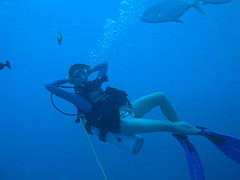After the near fatal tragedy off southern Taiwan earlier this week I thought I should give you diving enthusiasts some information to help make your dive a success in every sense. This comes courtesy of ‘Try Diving.net’ to whom I am very grateful.
18 Practices to Make You a Responsible Diver
- Make sure that you plan all your dives before you get into the water.
- Make sure that your deepest dive of the day is also your first dive of the day.
- The deepest part of each dive that you plan should be reached at the beginning of your dive.
- Try to avoid exerting yourself during your dive. You should also avoid physical activity for half an hour after your dive has finished.
- Check your dive computer and/or guages often throughout your dive.
- If you are diving in cold water or after strenuous activity, make sure that you begin your ascent before you reach your no-decompression limit.
- Always act in compliance with the ascent rate that is indicated by your dive computer.
- Always carry out a 3-minute safety stop between 20 feet (6 meters) and 10 feet (3 meters).
- Try to avoid decompression stop dives and be absolutely certain not to dive deeper than 130 feet (40 meters) unless you are a specially trained deep diver.
- When you are doing a decompression dive, prolong the decompression stop nearest to the surface.
- After all of your decompression stops, ascend to the surface very slowly.
- Always make sure that you are not “yo-yo” diving (repetitively ascending and descending under the water).
- Do not carry out any dive until the desaturation time, as dictated by your previous dive, has passed.
- Avoid repeatedly diving to a single depth deeper than 60 feet (18 meters). N.B. Repeated diving to the same depth is known as ‘square diving’.
- Be sure to separate any repetitive dives by at least a 2 hour surface interval.
- If you are planning repetitive dives for a number of consecutive days, be sure to take at least one day off from diving each week. The recommended number of consecutive time diving should not exceed 3 days i.e. take 1 day off every 3 days.
- Be certain that you do not go mountain climbing or take a plane flight for at least 12 hours (preferably 24 hours) after a dive.
- Finally, never try to exceed the limits of your experience and skill.
So there you have it – I can certainly relate to the second last tip – some years ago after diving in the Indian Ocean off of Pemba Island, Tanzania I stupidly climbed into a light aircraft to fly to Nairobi, Kenya. It had been a beautiful dive, incredible visibility and the most wonderful fan corals 5 metres across and then the flight past Mt. Kilimanjaro was equally inspiring – but boy oh boy did I regret that flight. We landed at Wilson Airport where I collapsed with an excruciating headache. To cut a long story short – I recovered – but take note – you have been warned. The only other thing I would add, which I’m sure our Taiwanese diving friends would endorse, is do be aware of the winds and currents in the ocean and make sure in your dive plan that the rendez vous on the surface is agreed and understood by all. This is after all an extreme sport which involves risk but with careful planning this world of a different dimension can and should be enjoyed by all.




